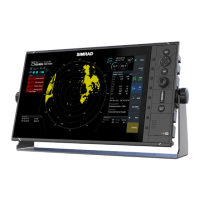Alert type Icon State Indication
Warning
Active - not
acknowledged, not
silenced
• Flashing symbol
and descriptive
text
• Audible signal
Active - not
acknowledged,
silenced
• Flashing symbol
and descriptive
text
• No audible signal
Active -
acknowledged
• Steady symbol and
descriptive text
• No audible signal
Active - responsibility
transferred
• Steady symbol and
descriptive text
• No audible signal
Rectified - not
acknowledged
• Flashing symbol
and descriptive
text
• No audible signal
Caution
Active
• Steady symbol and
descriptive text
• No audible signal
Acknowledging alerts
The Alerts softkey is labelled Alerts Acknowledge if there is an un-acknowledged alarm or
warning in the system.
You acknowledge the most recent alarm or warning by pressing the Alerts Acknowledge
softkey. The cursor is then automatically moved to the Alerts panel, and you can use the
arrow keys to move up and down in the list of alerts.
Repeat pressing this softkey to continue to acknowledge alerts from the top of the Alerts
panel. The sort order of alerts is the severity (i.e. alarm before warning), then age.
If no active alerts or warnings are present, the softkey is labelled Alerts. Pressing this key
moves the cursor to the Alerts panel.
Press the EXIT key to exit the Alerts panel.
When an Alarm or Warning is acknowledged, the alert icon stops flashing and changes to the
acknowledged icon. The siren continues to sound if there are remaining unacknowledged
alarms or warnings, otherwise it is muted.
The acknowledged alert is not moved to its new position in the sort order until there has
been 2 seconds without any alerts being acknowledged.
All alerts remain in the Alerts panel until the reason for the alarm is rectified.
The Alerts dialog
The Alerts dialog includes a list of active alerts together with a historic listing of the last 100
alerts. All alerts in the Alerts dialog include a time stamp.
The alert system | R2009/R3016 User manual
63

